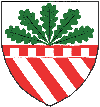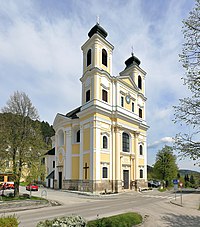Altenmarkt an der Triesting
|
market community Altenmarkt an der Triesting
|
||
|---|---|---|
| coat of arms | Austria map | |
|
|
||
| Basic data | ||
| Country: | Austria | |
| State : | Lower Austria | |
| Political District : | to bathe | |
| License plate : | BN | |
| Surface: | 63.52 km² | |
| Coordinates : | 48 ° 1 ′ N , 16 ° 0 ′ E | |
| Height : | 390 m above sea level A. | |
| Residents : | 2,102 (January 1, 2020) | |
| Population density : | 33 inhabitants per km² | |
| Postcodes : | 2564, 2565, 2571, 2572 | |
| Area code : | 02673 | |
| Community code : | 3 06 02 | |
| NUTS region | AT122 | |
| Address of the municipal administration: |
Altenmarkt 32 2571 Altenmarkt an der Triesting |
|
| Website: | ||
| politics | ||
| Mayor : | Josef Balber ( ÖVP ) | |
|
Municipal Council : ( 2020 ) (21 members) |
||
| Location of Altenmarkt an der Triesting in the Baden district | ||
 Row of houses in the center of Altenmarkt |
||
| Source: Municipal data from Statistics Austria | ||
Altenmarkt an der Triesting is a market town with 2102 inhabitants (as of January 1, 2020) on the southern edge of the Vienna Woods on the old pilgrimage route Via Sacra approx. 30 km southwest of Vienna in the Triestingtal .
geography
The capital Altenmarkt and Thenneberg are located in the valley floor of the Triestingtal and thus on the Leobersdorfer Bahn , which has been disused in this section, and on the Triestingtalbundesstraße B18 . The other villages are a bit out of the way: Klein-Mariazell and St. Corona in a side valley towards Klausenleopoldsdorf , the towns of Nöstach and Hafnerberg on the Hafnerberg mountain pass of the same name towards Alland .
Community structure
The municipality includes the following localities (Altenmarkt an der Triesting: market, otherwise: villages). Population figures as of January 1st, 2020 in brackets:
- Altenmarkt an der Triesting (527)
- Mountain and ditch
- Dörfl
- Dornau
- Hafnerberg
- Höfnergraben
- Klauswies
- Klein-Mariazell (210)
- Kogel settlement
- Neuwald
- Nöstach (395)
- Reitel ditch
- St. Corona am Schöpfl (339)
- Sankt Coronastrasse
- Sulzbach (65)
- valley
- Tasshof
- Thenneberg (566)
- Moat
The community consists of the cadastral communities Altenmarkt, Kleinmariazell , Nöstach , St. Corona and Thenneberg .
Neighboring communities
- in the Baden district
- Alland with the villages of Groisbach , Mayerling , Maria Raisenmarkt , Untermeierhof and Holzschlag .
- Klausen-Leopoldsdorf
- Weissenbach with the villages of Neuhaus , Schwarzensee and Gadenweith .
- Furth
- in the Lilienfeld district
- in the St. Pölten district
history

See also: History of the Vienna Woods .
Like Nöstach-Hafnerberg and Thenneberg, Altenmarkt belonged to the rule of the Benedictine monastery of Mariazell in Austria , which is now Klein-Mariazell , which was founded in 1134 or 1136 . About 8 km to the north-west, St. Corona was built as a timber house settlement and has its own historical development.
Altenmarkt had developed into an economic center of the region for a long time - mainly due to the hydropower of the Triesting -, as in contrast to the surrounding towns, which were mostly rural, mainly craftsmen and merchants had settled here. For this reason, Abbot Michael I asked the later Emperor Friedrich III. to be able to hold a weekly market here every Saturday, which he was granted. The related privilege was issued in 1448.
After the great Turkish invasion of 1529 - as a result of which the country was devastated, three monks of the monastery were murdered by the invaders, and the population was severely decimated - the market declined again and despite hard efforts, especially by Abbot Valentin Stambler ( 1618–1653), are no longer introduced.
The second and third invasions of the Turks in 1532 and 1683 also had a lasting effect on the Triesting Valley: the monastery and the houses in the surrounding villages were burned down. The loss of population was made up for by immigration from other countries of the Habsburg Empire around 1694. St. Corona was settled.
The monastery also suffered from the spirit of the Reformation well into the 17th century : disputes with Protestant landlords in the area and the lack of clergy led so far that the churches in Altenmarkt and Nöstach could no longer be occupied by priests, and often the abbot of the was the only clergyman in the monastery. The services were therefore held at this time in the parish church of St. Thomas, which was located in the monastery. The other places of worship were neglected.
The 18th century brought industry into Triestingtal - which was reflected for the community Altenmarkt particular from 1802 in located at the Triesting rotting Tasshof: through the establishment of an existing until 1841 Metallwarenfabrik, between 1819 and 1825 supplemented by a white bleaching , in turn, subsequently expanded into a cotton mill or, after a fire, rebuilt in 1828 and in operation until 1865.
The economic as well as cultural effects: stucco ceilings, facades and churches were designed in the baroque style and new church buildings were built in 1719–1721 in St. Corona, 1729–1745 on Hafnerberg and 1754–1774 in Dornau in Thenneberg. Restaurants and houses are being built in Nöstach and Thenneberg and a school in St. Corona.
In 1844 a post office was built in Altenmarkt, but it was closed again in 1877 due to the construction of the Leobersdorfer Bahn.
In 1848 the manor was abolished, the political districts and municipalities were formed, and in the following years the mayor was elected for the first time.
1875 A gendarmerie post was set up in house number 64 and remained in place until 1972.
In 1883, today's house No. 61 was built as a post office and the postal savings bank service was introduced at the same time.
In 1891 the Altenmarkt volunteer fire brigade was founded in a wooden prop house next to the post office. The first captain was the master baker Leopold Weninger.
In 1921, Altenmarkt and Thenneberg were finally connected to the telephone network.
In 1928 the fire brigade moved into a brick building on the site of the old prop house. This was used by the fire brigade until 1989, before they moved into their new house on the other side of the Triesting at the level crossing.
In 1945 towards the end of the war, in April, fierce fighting began, especially on Hafnerberg, Nöstach and St. Corona. The Hafner Bridge, a beautiful bridge resting on three arches, was blown up by the retreating German Wehrmacht; the remains are still clearly visible today. The Hocheck refuge was burned down by the Russians and the Altenmarkt pastor Leopold Wieshaupt was shot. See also history of Alland .
As part of the community reform completed in 1972, Altenmarkt, Nöstach, Kleinmariazell, Thenneberg and St. Corona - and their offices and schools - were merged in Altenmarkt.
The 1970s to the 1990s were characterized by the rural exodus, the deaths of grocers and farmers, the settlement of refugees from the Eastern Bloc, but also by economic growth and the construction of a soccer field, tennis facility, multi-purpose hall and canal network.
Parts of the market town were affected by the floods of the Triesting and its tributaries at irregular intervals (most recently in 1846, 1848, 1850, 1901, 1913, 1926, 1944, 1966, 1991, 1997 and 2002).
Population development
| census | Residents |
|---|---|
| 2011 | 2,092 |
| 2001 | 2,052 |
| 1991 | 2,060 |
| 1981 | 1,733 |
| 1971 | 1,754 |
Source: Population development of Altenmarkt an der Triesting. (PDF) Statistics Austria
politics
The municipal council has a total of 21 members.
- With the municipal council elections in Lower Austria 2020 , the municipal council has the following distribution: 15 ÖVP, 4 SPÖ, and 2 FPÖ.
- mayor
- until 2007 Alois Nöstler (ÖVP)
- since 2007 Josef Balber (ÖVP)
Culture and sights
- Klein-Mariazell basilica
- Parish church Altenmarkt an der Triesting
- Pilgrimage church Hafnerberg
- Pilgrimage Church Dornau
- Parish Church of St. Corona am Schöpfl
Personalities
- Sons and daughters of the church
- Johann Blieberger, professor at the Vienna University of Technology, author of specialist books on railway history
- Karl Luze (1864–1949), Imperial and Royal Court Kapellmeister; 1903–1918 first conductor and head of the KuK Hof-Musik-Kapelle
- Josef Tölk (1861–1927), architect
- Franz Schulz (1891–1956), politician
- People related to the community
- Thomas Aigner (* 1973), historian
- Josef Balber (* 1962), Mayor and Member of the State Parliament of Lower Austria
- Matthias Schorn (* 1982 in Bad Vigaun ), principal clarinet of the Vienna Philharmonic , lives in Altenmarkt
literature
- Leo Wirtner, Hans Wießhofer (among others): Festschrift of the market community Altenmarkt an der Triesting on the occasion of the re-awarding of the market coat of arms 1983 - market community Altenmarkt, Altenmarkt an der Triesting 1983.
Web links
- 30602 - Altenmarkt an der Triesting. Community data, Statistics Austria .
- Entry on Altenmarkt an der Triesting in the database of the state's memory for the history of the state of Lower Austria ( Museum Niederösterreich )
- Topothek Altenmarkt / Triesting historical images, located, tagged and dated
Individual evidence
- ↑ 4th part: Municipalities - Lower Austria - 12. Altenmarkt an der Triesting . In: Austrian official calendar online . Jusline Österreich (Verlag Österreich), Vienna 2002–, ZDB -ID 2126440-5 , accessed on July 24, 2015.
- ↑ Statistics Austria: Population on January 1st, 2020 by locality (area status on January 1st, 2020) , ( CSV )
- ^ A b Eva Wald: The beginnings of the industry in the Vienna basin and its geographical basis . Vienna, Univ., Diss., 1954, Permalink Austrian Library Association , p. 249 f.
- ^ Walter Rieck: Cultural geography of the Triestingtal. Vienna, Univ., Diss., 1957, catalog list Austrian National Library , p. 111.
- ↑ Results of the 2020 municipal council election in Altenmarkt an der Triesting. Office of the Lower Austrian State Government, January 26, 2020, accessed on January 29, 2020 .
- ↑ ÖNB









